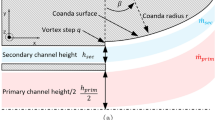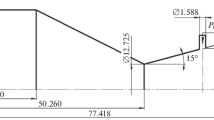Abstract
During the last years, several thrust control systems of aerospace rocket engines have been developed. The fluidic thrust vectoring is one of them; it is simple in design and offers a substantial gain in weight and in performance. Most of the studies related to this device were carried out with cold gas. It is quite legitimate to expect that the thermophysical properties of the gases may affect considerably the flow behavior. Besides, the effects of reacting gases at high temperatures, under their effects all flow parameters like to vary. This study aims to develop a new methodology that allows studying and analyzing the fluidic thrust vectoring for a perfect gas, by taking into account the effects chemical reactions on the flow parameters, such as separation point, reattachment point downstream and pressure distribution upstream the injection port. In this study, the thrust vectorization implying frozen reacting hot gases was carried out by considering a chemical reaction mechanism. The thermodynamic parameters of the flow are calculated within the combustion chamber and different sections of the supersonic part of the nozzle. The results show a good agreement for cold gas, and as expected a slight difference for hot reacting gases. In parallel, in order to give more credibility to our work a study was carried out by numerical simulation for supersonic reactive and perfect flows in order to analyze the results of the method developed. In this work, the CFD performance of the fluidic thrust vectoring has been qualitatively and quantitatively analyzed. The Schlieren visualization and the wall pressure results are compared to analytical and experimental findings. Performance analysis is conducted, and basic conclusions are drawn in terms of thermodynamic gas properties effect on the fluidic thrust vector system. The primary effect was related to the gas molecular weight and its specific heat ratio. It is observed that for fixed injection conditions, the vectoring angle is different when the injected gas molecular weight and specific heat ratio are different. For a given mission of the launcher, it can be concluded that the mass of the embedded gas, used for the fluidic vectorization system, can be significantly reduced, depending on its molecular weight and specific heat ratio.
















Similar content being viewed by others
Abbreviations
- A :
-
Section (m2)
- F x :
-
Axial effort (Kg m/s2)
- F y :
-
Normal effort (Kg m/s2)
- h :
-
Fluidic obstacle height (m)
- M :
-
Mach number
- ṁ :
-
Mass flow (Kg/s)
- P, p :
-
Total pressure and static pressure (Pa)
- V :
-
Velocity vector
- u :
-
Axial velocity (m/s)
- a :
-
Velocity of sound (m/s)
- T :
-
Temperature (K)
- x :
-
Axial direction
- y :
-
Normal direction
- γ :
-
Ration of specific heats (γ = cp/cv)
- δ :
-
Thrust vector angle (°)
- ρ :
-
Density (Kg/m3)
- C P :
-
Specific heat at constant pressure of mixture (J/Kg-K)
- H :
-
Specific enthalpy of mixture (J/Kg)
- S :
-
Specific entropy of mixture (J/Kg-K)
- R :
-
Universal gas constant (J/mole-K)
- C :
-
Molar concentration (mole/m3)
- M s :
-
Molar mass of the species s (Kg/mole)
- av:
-
Conditions of flow downstream of the control volume
- j :
-
Injection conditions
- s :
-
Separation
- t :
-
Throat of the nozzle
- b :
-
Width of the injection slot (m)
- 0:
-
Stagnation conditions
- 1:
-
Flow condition downstream of the shock
- NPR:
-
Nozzle pressure ratio pressure = Poi/pa
- SPR:
-
Secondary pressure ratio = Poj/Poi
- SVC:
-
Shock vector control principle of injection in the divergent
- CN:
-
Conical nozzle
References
Sellam, M.; Chpoun, A.; Zmijanovic, V.; Lago, V.: Fluidic thrust vectoring of an axisymmetrical nozzle: an analytical model. Int. J. Aerodynamics. 2(2–4), 193–209 (2012). https://doi.org/10.1504/IJAD.2012.049112
Sellam, M.; Zmijanovic, V.; Leger, L.; Chpoun, A.: Assessment of gas thermodynamic characteristics on fluidic thrust vectoring performances: Analytical, experimental and numerical study. Int. J. Heat Fluid Flow 53, 156–166 (2015). https://doi.org/10.1016/j.ijheatfluidflow.2015.03.005
Maarouf, N.: Modélisation des Phénomènes Dissymétriques Dans le Divergent des Tuyères Supersoniques Propulsives : Application à la Vectorisation de la Poussée . Thesis, University of Evry-val d’Essonne. (2008)
Zmijanovic, V.; Lago, V.; Leger, L.; Depussay, E.; Sellam, M.; Chpoun, A.: Thrust vectoring effects of a transverse gas injection into a supersonic cross flow of an axisymmetric convergent-divergent nozzle. Prog. Propuls. Phys. 4, 227–256 (2013). https://doi.org/10.1051/eucass/201304227. (EDP Sciences)
Van Pelt, H.; Neely, A.; Young, J.: A system study on fluidic thrust vectoring. In: International Space Planes and Hypersonic Systems and Technologies Conferences. Glasgow, Scotland, July 6–9 (2015). https://doi.org/10.13140/rg.2.1.1710.1287
Zmijanovic, V.; Lago, V.; Sellam, M.; Chpoun, A.: Thrust shock vector control of an axisymmetric conical supersonic nozzle via secondary transverse gas injection. Shock Waves J. (2013). https://doi.org/10.1007/s00193-013-0479-y
Waithe, K.A.; Deere, K.A.: Experimental and computational investigation of multiple injection ports in a convergent-divergent nozzle for fluidic thrust vectoring. In: 21 st AIAA Applied Aerodynamics Conference, Orlando, Florida (2003)
Ferlauto, M.; Marsilio, R.: Numerical investigation of the dynamic characteristics of a dual-throat-nozzle for fluidic thrust-vectoring. AIAA J. 55, 1 (2017). https://doi.org/10.2514/1.j055044
Van Pelt, H.; Neely, A.; Young, J.: A System study on fluidic thrust vectoring. In: International Space Planes and Hypersonic Systems and Technologies Conferences. Glasgow, Scotland, July 6–9 (2015). https://doi.org/10.2514/6.2015-3565
Deng, R.; Kong, F.; Kim, H.D.: Numerical simulation of fluidique thrust vectoring in an axisymmetric supersonic nozzle. J. Mech. Sci. Technol. (2014). https://doi.org/10.1007/s12206-014-1119-x
Jerin, J.; Subanesh Shyam, R.; Aravind Kumar, T.R.; Naveen, N.; Vignesh, R.; Krishna Ganesh, B.; Sanal Kumar, V.R.: Numerical studies on thrust vectoring using shock induced supersonic secondary jet. Int. J. Mech. 7(8), 1714–1720 (2013)
Mangin, B.; Chpoun, A.; Jacquin, L.: Experimental and numerical study of the fluidic thrust vectoring of a two-dimensional supersonic nozzle. AIAA Paper 2006–3666. (2006)
Jun, Y.H.; Hong, G.S.: Fluidic thrust-vector control of supersonic jet using coflow injection. J. Propul. Power 28(4), 858–861 (2012)
Flamm, J.D.; Deere, K.A.; Mason, M.L.; Berrier, B.L.; Johnson, S.K.: Experimental study of an axisymmetric dual throat fluidic thrust vectoring nozzle for supersonic aircraft application. In: 43rd Joint Propulsion Conference & Exhibit, July 2007, Cincinnati, OH
Spaid, F.W.; Zukoski, E.E.: A study of the interaction of gaseous jets from transverse slots with supersonic external flows. AIAA J. 6(2), 205–212 (1968)
Billig, F.S.: Shock-wave shapes around spherical- and cylindrical-nosed bodies. J. Spacecr. Rockets 4(6), 822–823 (1967)
Zukoski, E.E.: Turbulent boundary-layer separation in front of a forward-facing step. AIAA J. 5(10), 1746–1753 (1967)
Chapman, D.R.; Huehn, D.M.; Larson, H.K.: Investigation of separated flows in supersonic and subsonic streams with emphasis on the effect of transition. Technical Report NACA TR 1356, NACA, (1958)
Schmucker, R.H.: Status of flow separation prediction in liquid propellant rocket nozzles. NASA TM X-64890. (1973)
Reshotko, E.; Tucker, M.: Effect of a discontinuity on turbulent boundary-layer thickness parameters with application to shock-induced separation. NACA TN 3454. (1955)
Campbell, C.; Farley, J.: Performance of several conical convergent-divergent rocket-type exhaust nozzles. NASA TN D-467. (1960)
Green, L.: Flow separation in rocket nozzles. ARS J 23(1), 34–35 (1953)
Schilling, M.: Flow separation in a rocket nozzle. M.S. Thesis, University of Buffalo. (1962)
Kalt, S.; Badal, D.: Conical rocket nozzle performance under flow separated conditions. J. Spacecr. Rockets 2(3), 447–449 (1965)
Bloomer, H.; Antl, R.; Renas, P.: Experimental study of effects of. Geometric variables on performance of conical rocket engine exhaust nozzles. NASA J. 21(9), (1961)
Summerfield, M.; Foster, C.; Swan, W.: Flow separation in overexpanded supersonic exhaust nozzles. Jet Propul. 24(5), 319–321 (1954)
Davidenko, D.M.; Gökalp, I., Duffour, E., Magre, P.: Systematic numerical study of the supersonic combustion in an experimental combustion chamber. AIAA Paper 2006–7913
Gordon, S.F.; McBride, B.J.: Computer program for calculation of complex chemical equilibrium compositions and applications. NASA RP-1311, NASA Glenn Research Center, (1996)
Gordon, S.F.; McBride, B.J.: Computer program for calculation of complex chemical equilibrium compositions and applications. NASA RP-1311, (1994)
CFD-FASTRAN: Theory manual version. (2003)
Menter, F.R.: Zonal two equation turbulence models for aerodynamic flows. AIAA 24th Fluid Dynamics Conference, 6–9 July. (1993)
Author information
Authors and Affiliations
Corresponding author
Rights and permissions
About this article
Cite this article
Chouicha, R., Sellam, M. & Bergheul, S. Effect of Chemical Reactions on the Fluidic Thrust Vectoring of a Plane Nozzle. Arab J Sci Eng 45, 7191–7204 (2020). https://doi.org/10.1007/s13369-020-04350-8
Received:
Accepted:
Published:
Issue Date:
DOI: https://doi.org/10.1007/s13369-020-04350-8




